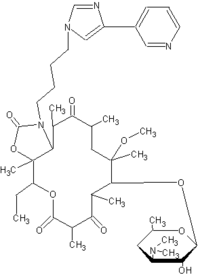Synopsis
Telithromycin is the first member of the ketolides, a new subclass of the macrolide class of antibiotics. Its activity against common respiratory pathogens is similar to that of macrolide antibiotics clarithromycin (Biaxin) and azithromycin (Zithromax), but with in vitro and in vivo activity against both pencillin-resistant and macrolide-resistant Streptococcus pneumoniae. Telithromycin is labeled for treatment of community-acquired pneumonia (CAP), acute exacerbations of chronic bronchitis (AECB), and acute sinusitis (AS) in adults.
Safety
As with other currently available fluoroquinolone and macrolide antibiotics, QTc interval prolongation has been linked to the use of telithromycin. Its effect on the QTc interval is small and does not appear to be clinically significant, except perhaps in patients already at risk because of older age, preexisting medical conditions (e.g., coronary heart disease, hypokalemia, cerebrovascular disease, hypomagnesemia), or other medications (e.g., antiarrhythmics, tricyclics, phenothiazines). (1) Increased liver transaminase levels (AST and ALT) have been reported in clinical trials, but the elevations were modest and occurred more frequently in patients with higher baseline levels. Rates of transaminase increases to three times the upper limit of normal were similar to those seen in patients not taking the drug.
Telithromycin is primarily metabolized by the hepatic CYP450 3A4 enzymes, although it has not been shown to be affected by grapefruit juice (which is known to affect drug metabolism in this group of hepatic enzymes). Concurrent administration of telithromycin may result in increased serum levels of simvastatin, digoxin, and midazolam, but no specific dosage adjustments are recommended. (2,3) Telithromycin is Pregnancy Category C. It has not been studied in patients younger than 13 years.
Tolerability
The side effects of telithromycin are similar to those of clarithromycin and azithromycin. Most frequently reported side effects included diarrhea (13 percent), nausea (8.1 percent), dizziness (3.6 percent), and vomiting (2.8 percent). (2) In comparison studies, clarithromycin and amoxicillin/clavulanate (Augmentin) had 7.3 percent and 18 percent rates of diarrhea, respectively. (2) Discontinuations were one half the rate reported with amoxicillin/clavulanate. There are no direct comparison studies with azithromycin or clarithromycin. Telithromycin should not be used in patients with a demonstrated allergy to macrolide antibiotics.
Effectiveness
Telithromycin is effective against the same pathogens as the macrolides, but may offer the benefit of coverage against penicillin and macrolide-resistant S. pneumoniae. Clinical trials have shown that telithromycin 800 mg daily is similar in effectiveness to amoxicillin 1,000 mg three times a day, amoxicillin/clavulanate 500 mg three times a day, clarithromycin 500 mg twice daily, trovafloxacin (Trovan) 200 mg daily, and cefuroxime axetil (Ceftin) 500 mg twice daily for the treatment of CAP, AECB, and AS. (1,2) Telithromycin maintained clinical and bacteriologic activity against resistant S. pneumoniae, but the advantage of this benefit for most respiratory infections has yet to be determined. (4)
Price
The cost of a 10-day course of therapy of Ketek is about $113. This compares to the 10-day course prices of Augmentin at approximately $117 and Biaxin at about $121.
Simplicity
The adult dose of telithromycin is 800 mg once daily, administered as two 400-mg tablets at the same time. Absorption is not affected by food. The duration of treatment is only five days for AECB and AS and seven days for community-acquired pneumonia. A dosage reduction to 400 mg daily is recommended for patients with severe renal insufficiency (creatinine clearance less than 30 mL per min [0.5 mL per s]). An intravenous formulation and a pediatric suspension are in development.
Bottom line
Telithromycin is similar to azithromycin and clarithromycin in side effects, dosing, and cost, but with enhanced activity against S. pneumoniae. Although 30 to 40 percent of S. pneumoniae cases are thought to be resistant to penicillin and/or macrolides, additional clinical trials are needed to determine the clinical relevance of this enhanced activity. Trials to date show similar rates of clinical cure in common respiratory infections. Telithromycin should be considered as an alternative to amoxicillin/clavulanate or respiratory fluoroquinolones for treatment of confirmed (laboratory) or suspected (because of poor clinical response to other antibiotics) infections of resistant S. pneumoniae.
STEPS drug updates cover Safety, Tolerability, Effectiveness, Price, and Simplicity.
The series coordinator is Allen F. Shaughnessy, Pharm.D., director of medical education at Pinnacle Health System, Harrisburg, Pa.
REFERENCES
(1.) Shain CS, Amsden GW. Telithromycin: the first of the ketolides. Ann Pharmacother 2002;36:452-64.
(2.) Zhanel GG, Walters M, Noreddin A, Vercaigne LM, Wierzbowski A, Embil JM, et al. The ketolides: a critical review. Drugs 2002;62:1771-804.
(3.) Aventis Pharma. Ketek (telithromycin package insert. 2003. Accessed online August 24, 2004, at: http://www.aventis-us.com/PIs/ketek.pdf.
(4.) Fogarty CM, Kohno S, Buchanan P, Aubier M, Baz M. Comunity-acquired respiratory tract infections caused by resistant pneumococci: clinical and bacteriological efficacy of the ketolide telithromycin. J Antimocrob Chemotherapy 2003;51:947-55.
M. SHARM STEADMAN, PHARM.D., BCPS, CDE, is professor in the department of family and preventive medicine, University of South Carolina School of Medicine, Columbia.
S. SCOTT SUTTON, PHARM.D., is clinical assistant professor, College of Pharmacy, University of South Carolina, Columbia.
COPYRIGHT 2004 American Academy of Family Physicians
COPYRIGHT 2004 Gale Group



